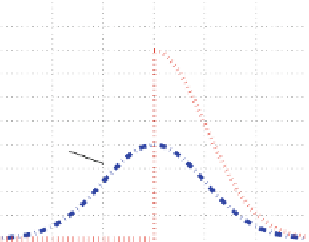Digital Signal Processing Reference
In-Depth Information
a
b
TRANSFORMATION OF NORMAL R.V.
Y=ab
s
(X)
1
3
0.9
2.5
0.8
0.7
2
OUTPUT PDF
0.6
1.5
0.5
INPUT PDF
0.4
1
0.3
0.5
0.2
0.1
0
-3
-2
-1
0
1
2
3
0
−2
−1
0
1
2
3
−3
X
x, y
Fig. 4.9
Absolute value of a normal random variable. (
a
) Transformation. (
b
) Input and output
PDFs
Solution
The random variable
Y
takes only two discrete values:
0.3 and 0.3.
Consequently, the random variable
Y
is a discrete random variable and its PDF will
have two delta functions:
f
Y
ðyÞ¼PfY ¼
0
:
3
gdðy
0
:
3
ÞþPfY ¼
0
:
3
gdðy þ
0
:
3
Þ:
(4.83)
From (
4.82
), the random variable
Y
has the value 0.3 if the random variable
X
is
positive. Therefore,
PfY ¼
0
:
3
g¼PfX>
0
g¼
0
:
5
:
(4.84)
Similarly,
PfY ¼
0
:
3
g¼PfX<
0
g¼
0
:
5
:
(4.85)
From (
4.83
)to(
4.85
), we have:
f
Y
ðyÞ¼
0
:
5
dðy
0
:
3
Þþ
0
:
5
dðy þ
0
:
3
Þ:
(4.86)
The input and output PDFs along with the transformation are shown in Fig.
4.10
.
A normal random variable can also be transformed into a mixed random
variable, as shown in the following example.
Example 4.3.5
The normal random variable has a mean value equal to 0, and a
variance equal to 1. Find the PDF of the random variable
Y
,if
8
<
1
for
X>
1
Y ¼
X
for
1
<X<
1
;
(4.87)
:
1
X<
1
for
as shown in Fig.
4.11a
.































































































































Search WWH ::

Custom Search